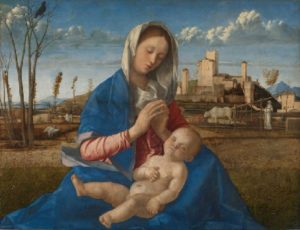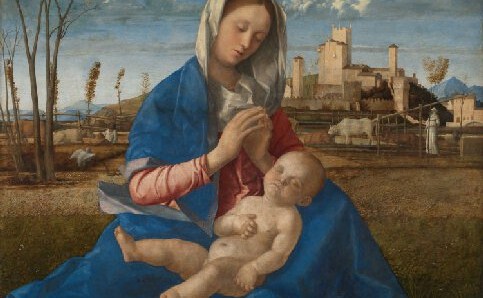06 December 2019
Mantegna and Bellini
The National Gallery (until 27 January 2019).
Reviewed by William Morton

Time for two major Old Masters, who were contemporaries, court painters and related by marriage.
Andrea Mantegna (c.1431- 1506) studied in Padua under a painter called Squarcione, who passed on to him an interest in Roman sculpture and archaeology. He married Bellini’s sister in 1453 and, after spending some time in Verona, was appointed painter to the Gonzaga Court of Mantua in 1460 where he spent the rest of his life, apart from a visit to Rome in 1488-90 to paint frescoes in the Vatican (destroyed by a later Pope). His fortunes tended to fluctuate with changes in the ruler of Mantua.
Giovanni Bellini (c.1430-1516) was a member of a leading Venetian family of painters, with both his father, Jacopo, and his brother, Gentile, being well-known artists. He was appointed Conservator of the pictures in the Great Hall of the Doge’s Palace around 1479 and received numerous commissions from Venetian bodies and churches. Many of his works have been lost. Titian and Giorgione are said to have been pupils of his.
Typical of their time, many of the paintings of the two men are of religious subjects. The exhibition has hung certain of their paintings of the same scene side by side, which is fascinating. Mantegna’s version of The Agony in the Garden is more austere with sharp colour-contrast while Bellini’s is softer, showing Christ silhouetted against the dawn. In Mantegna’s St Jerome in the Wilderness, there is a lot of detail such as a little owl perched above the Saint and a discarded sandal, and the lion peers out from behind his legs. Bellini’s is simpler with the lion in the foreground holding out its paw for attention. Remarkably similar are their paintings of The Presentation at the Temple except that Bellini has added an additional figure at each end. The end figures in Mantegna’s are possibly he himself and his wife, and those added by Bellini possibly he himself and his mother.
A very enjoyable feature of the work of both men is the background in their paintings. In Bellini’s Madonna del Prato, there is a fortified town, fields with oxen and a stork grappling with a snake. The picture repeats the ominous black crow sitting in a bare-branched tree found in Mantegna’s The Agony in the Garden. In Bellini’s St Jerome reading in a Landscape, the said landscape is almost Poussin-like with a walled town on the sea and the lion lurking behind a rock. In Mantegna’s St Sebastian, the Saint, pierced by arrows, stands against a background of classical ruins with detailed decoration and a cloud takes the form of a rider on a horse.
Given their early date, the two were highly proficient. Understanding of perspective was a recent development and the switch from tempera to oils occurred in their lifetime. Mantegna’ s accomplished St Mark the Evangelist was painted when he was only 17. A demonstration of their skill is their paintings of classical Roman scenes formed of statuary. Mantegna painted The Introduction of the Cult of Cybele to Rome shortly before his death. Bellini then took over the commission and produced The Continence of Scipio. The similarity of style is remarkable.
Mantegna and Bellini are great artists but the exhibition, which is very well worth seeing, does beg the question ‘Which is the greater?’. Bellini is considered to have a more human touch, and with paintings such as the Madonna del Prato and the portrait of Doge Leonardo Loredan is perhaps the better-known, but in the end it is probably just a matter of taste who you rate the more highly.


